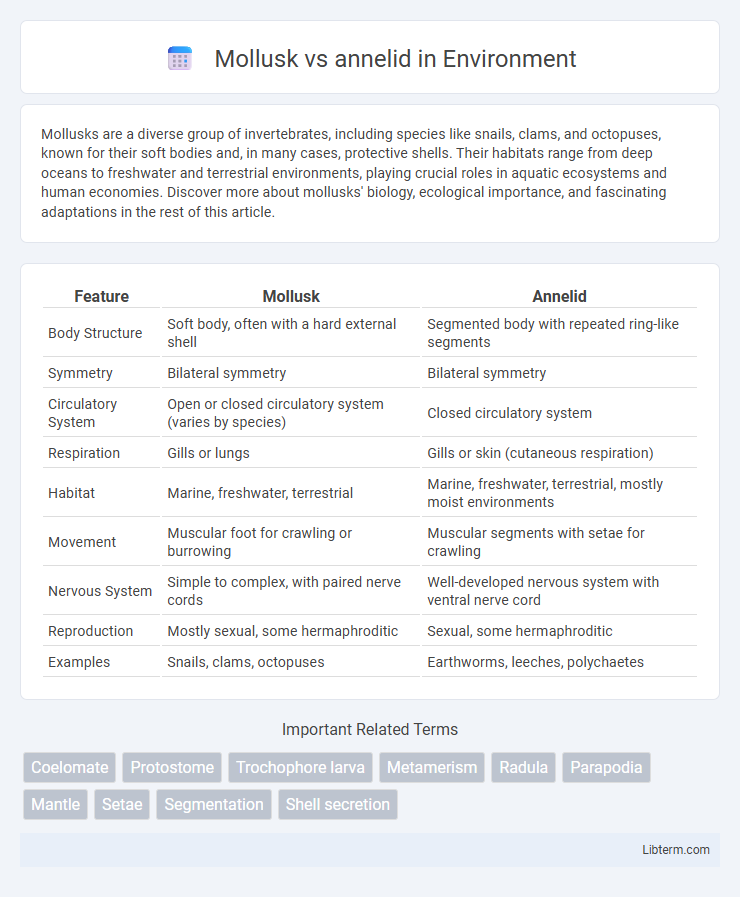Mollusks are a diverse group of invertebrates, including species like snails, clams, and octopuses, known for their soft bodies and, in many cases, protective shells. Their habitats range from deep oceans to freshwater and terrestrial environments, playing crucial roles in aquatic ecosystems and human economies. Discover more about mollusks' biology, ecological importance, and fascinating adaptations in the rest of this article.
Table of Comparison
| Feature | Mollusk | Annelid |
|---|---|---|
| Body Structure | Soft body, often with a hard external shell | Segmented body with repeated ring-like segments |
| Symmetry | Bilateral symmetry | Bilateral symmetry |
| Circulatory System | Open or closed circulatory system (varies by species) | Closed circulatory system |
| Respiration | Gills or lungs | Gills or skin (cutaneous respiration) |
| Habitat | Marine, freshwater, terrestrial | Marine, freshwater, terrestrial, mostly moist environments |
| Movement | Muscular foot for crawling or burrowing | Muscular segments with setae for crawling |
| Nervous System | Simple to complex, with paired nerve cords | Well-developed nervous system with ventral nerve cord |
| Reproduction | Mostly sexual, some hermaphroditic | Sexual, some hermaphroditic |
| Examples | Snails, clams, octopuses | Earthworms, leeches, polychaetes |
Introduction to Mollusks and Annelids
Mollusks, belonging to the phylum Mollusca, are invertebrates characterized by soft bodies, often protected by a calcium carbonate shell, and include species such as snails, clams, and squids. Annelids, classified under the phylum Annelida, are segmented worms with a body divided into ring-like segments, exemplified by earthworms, leeches, and polychaetes. Both groups exhibit bilateral symmetry and a coelom, but mollusks have a mantle and muscular foot, whereas annelids possess a hydrostatic skeleton and setae for movement.
Defining Characteristics of Mollusks
Mollusks are invertebrates characterized by a soft, unsegmented body divided into a head, visceral mass, and muscular foot, often covered by a calcium carbonate shell. They possess a radula, a specialized feeding organ, and a mantle that secretes the shell and forms a cavity used for respiration and excretion. Unlike annelids, which have segmented bodies and a coelom divided by septa, mollusks have a reduced or absent segmentation and an open circulatory system in most classes.
Defining Characteristics of Annelids
Annelids are segmented worms characterized by their distinct body segmentation, a true coelom, and a closed circulatory system, which differentiates them from mollusks that lack segmentation and possess an open circulatory system. Annelids typically have setae (bristle-like structures) on each segment for locomotion and a well-developed nervous system with a ventral nerve cord. Unlike mollusks, annelids exhibit metamerism, where repetitive organ systems in each segment provide enhanced mobility and specialization.
Body Structure Comparison
Mollusks possess a soft, unsegmented body typically divided into a head, visceral mass, and a muscular foot, often protected by a calcium carbonate shell. Annelids exhibit a segmented body structure with repeating units containing similar organ systems, enabling efficient movement through peristalsis. Unlike mollusks, annelids have a coelom divided by septa, enhancing their structural complexity and allowing more precise control of their body segments.
Habitat and Distribution
Mollusks inhabit diverse environments, ranging from marine and freshwater to terrestrial ecosystems, with notable groups such as gastropods thriving in coastal zones and cephalopods in deep oceans. Annelids primarily occupy moist terrestrial soils and aquatic habitats, including freshwater streams and marine sediments, where polychaetes dominate oceanic depths. Distribution patterns reflect mollusks' adaptability to varied salinities and terrains, while annelids are mostly concentrated in environments with ample organic matter and stable moisture conditions.
Modes of Locomotion
Mollusks primarily utilize a muscular foot for locomotion, gliding over surfaces by secreting mucus and contracting muscles, while some species like octopuses use jet propulsion. Annelids rely on the coordinated contraction of circular and longitudinal muscles along with setae (bristle-like structures) to crawl through soil or water. These different modes reflect adaptations to their respective environments, with mollusks favoring sliding and burrowing and annelids excelling in peristaltic movement for burrowing and crawling.
Reproductive Strategies
Mollusks exhibit diverse reproductive strategies including external fertilization, internal fertilization, and hermaphroditism, with species like cephalopods engaging in complex mating behaviors and egg care. Annelids primarily reproduce sexually through cross-fertilization, with many species being hermaphroditic and using clitellum-produced mucus cocoons to protect fertilized eggs. Both groups show adaptations to aquatic and terrestrial environments, optimizing reproductive success through various developmental modes such as direct development or larval stages.
Ecological Roles and Importance
Mollusks play a crucial role in aquatic ecosystems as filter feeders, detritivores, and prey for numerous species, contributing to water filtration and nutrient cycling. Annelids, particularly earthworms, enhance soil fertility by aerating and decomposing organic matter, which promotes plant growth and supports terrestrial food webs. Both phyla maintain ecological balance by facilitating energy flow and nutrient recycling in their respective habitats.
Key Evolutionary Differences
Mollusks exhibit a distinct evolutionary feature with their coelomate body structure and a mantle that secretes a calcium carbonate shell, whereas annelids possess a segmented, metameric body plan with true coelom and setae for locomotion. The nervous system of mollusks typically includes ganglia and paired nerve cords, contrasting with the ventral nerve cord and segmental ganglia arrangement found in annelids. Key evolutionary differences also lie in their development patterns; mollusks often undergo trochophore larval stages, while annelids exhibit more diverse larval forms influenced by segmentation and ecological adaptations.
Conclusion: Mollusk vs Annelid
Mollusks and annelids differ significantly in their body structure, with mollusks exhibiting a soft, unsegmented body often protected by a calcium carbonate shell, while annelids possess a segmented, elongated body with a coelom. Both groups play crucial ecological roles, mollusks primarily as filter feeders and grazers in aquatic environments, and annelids as soil aerators and decomposers. Understanding these distinctions highlights their evolutionary adaptations and importance in diverse ecosystems.
Mollusk Infographic

 libterm.com
libterm.com